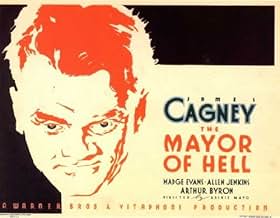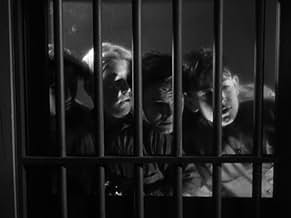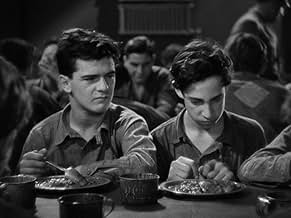ÉVALUATION IMDb
6,9/10
1,9 k
MA NOTE
Cinq membres d'un gang d'adolescents, dont le chef Jimmy Smith, sont envoyés au centre de réforme de l'État, présidé par l'insensible Thompson.Cinq membres d'un gang d'adolescents, dont le chef Jimmy Smith, sont envoyés au centre de réforme de l'État, présidé par l'insensible Thompson.Cinq membres d'un gang d'adolescents, dont le chef Jimmy Smith, sont envoyés au centre de réforme de l'État, présidé par l'insensible Thompson.
Allen 'Farina' Hoskins
- Smoke
- (as Farina)
G. Pat Collins
- Brandon
- (as George Pat Collins)
Histoire
Le saviez-vous
- AnecdotesPatsy is described as a "ward heeler" which is a political operative for a party during an election, mostly involved in vote canvassing. This means Patsy worked to deliver votes from his ward to a particular political machine that was willing to reward him for it.
- GaffesWhen Dorothy goes into her office and locks Patsy out, there is a table outside the door on which four books are resting. In the next shot, a closeup of the table top, there are only two books.
- Citations
Lawyer: Tell us what you know, I said! Never mind what you think!
Mr. Hemingway: Excuse me, boss. I ain't no lawyer. I can't talk without thinkin'.
Commentaire en vedette
Before the Dead End Kids, there was Frankie Darro. Forgotten today, he epitomized angry desperate youth during those early depression years. Here he comes across with his usual hot-headed intensity, enough to make up for a nonthreatening small size. In fact, Darro acts a lot like a younger version of Cagney, which is no accident since the story line depends on Cagney seeing a lot of himself among the brutalized boys of the reform school. Without that, his transformation from racketeer to reformer makes little sense.
Some good scenes, such as the regimented mess hall with its robotic commands and synchronized quick-step. Also, the movie really comes alive during the well-staged riot scene. The raging mob, flickering shadows and wildly burning torches create a disturbingly hellish scene befitting the title. Still, unless I missed something, the mob really is responsible for the cruel Dudley Digges death, allowing the boys to get away with murder or at least manslaughter no matter how much Digges deserves it. This may be an example of justice prevailing over the law during those pre-code days.
Showing how closely the school's operation is tied to greedy political patronage provides an interesting touch. Nonetheless, Cagney's conversion from corrupt ward healer to the George Washington of a boy's republic remains something of a stretch. And I'm sure the stereotype of the Jewish kid may have brought some chuckles in that day, but not in this post-holocaust period. Then too, the black kid's dad may be a crude stereotype, but the boy isn't, participating importantly in republic activities. Notice how subtly his role emerges, probably so as not to offend some audiences. Still, it was a nervy move for the time. Notice also, how deglamorized the boys are. With the many shapes and sizes, they look as though they were recruited off the streets-- another nice touch.
As in most Warner Bros. pictures of the time, there's an atmosphere of New Deal reform, embodied here by the understanding judge who's willing to try unorthodox methods to remedy social ills. All in all, the film stands as an entertaining period piece, with a humane message that stands the test of time.
Some good scenes, such as the regimented mess hall with its robotic commands and synchronized quick-step. Also, the movie really comes alive during the well-staged riot scene. The raging mob, flickering shadows and wildly burning torches create a disturbingly hellish scene befitting the title. Still, unless I missed something, the mob really is responsible for the cruel Dudley Digges death, allowing the boys to get away with murder or at least manslaughter no matter how much Digges deserves it. This may be an example of justice prevailing over the law during those pre-code days.
Showing how closely the school's operation is tied to greedy political patronage provides an interesting touch. Nonetheless, Cagney's conversion from corrupt ward healer to the George Washington of a boy's republic remains something of a stretch. And I'm sure the stereotype of the Jewish kid may have brought some chuckles in that day, but not in this post-holocaust period. Then too, the black kid's dad may be a crude stereotype, but the boy isn't, participating importantly in republic activities. Notice how subtly his role emerges, probably so as not to offend some audiences. Still, it was a nervy move for the time. Notice also, how deglamorized the boys are. With the many shapes and sizes, they look as though they were recruited off the streets-- another nice touch.
As in most Warner Bros. pictures of the time, there's an atmosphere of New Deal reform, embodied here by the understanding judge who's willing to try unorthodox methods to remedy social ills. All in all, the film stands as an entertaining period piece, with a humane message that stands the test of time.
- dougdoepke
- 19 oct. 2007
- Lien permanent
Meilleurs choix
Connectez-vous pour évaluer et surveiller les recommandations personnalisées
- How long is The Mayor of Hell?Propulsé par Alexa
Détails
- Date de sortie
- Pays d’origine
- Langues
- Aussi connu sous le nom de
- The Mayor of Hell
- Lieux de tournage
- société de production
- Consultez plus de crédits d'entreprise sur IMDbPro
Box-office
- Budget
- 229 000 $ US (estimation)
- Durée1 heure 30 minutes
- Couleur
- Mixage
- Rapport de forme
- 1.37 : 1
Contribuer à cette page
Suggérer une modification ou ajouter du contenu manquant

Lacune principale
By what name was Le Bataillon des sans-amour (1933) officially released in India in English?
Répondre




































